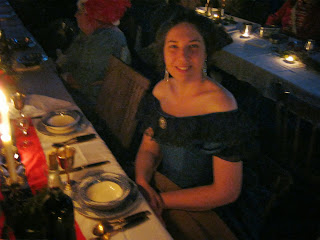I have been very busy with my university studies over the last few months. While I have slowed down on my sewing I have not stopped. I have, however, not been able to take many photos of my work as I have had to make the most of my free time. Normally, I use events as an opportunity to photograph completed items, but I have not been attending as many. As a result, I will probably just flood posts as I get a chance to photograph them.
A while ago I fell in love with the sleeves on this
dress from the Philadelphia Museum of Art. Mainly I really love the sleeves. I like that this dress tailors in the top of the bishop sleeve to streamline the look more.
For our second wedding anniversary Nic purchased some beautiful blue cotton to make a new dress for around the house and the fabric seemed perfect to make a dress with these sleeves. It took longer to make than anticipated as I had to toile a new bodice from scratch. While I was unable to take construction photos, I have some completed photos showing the fastenings.
For this dress I decided to use a dog leg closure. I also intend to add pockets at a later date to make it more usable and practical. This is also the first time that I have put the hooks under a placket and the eyelets into the seams. I copied this form of closure from some originals on '
All the Pretty Dresses' blog, which is an excellent and drool worthy resource.
The sleeve cap was fairly simple to draft as it is fitted into the arm hole. It is piped on the top and the bottom and is lined in white cotton to provide strength and assist it to sit nicer with the weight of the bishop sleeve under it.
The bishop sleeve is a basic bishop sleeve that has been drafted straight on the top and curved at the wrist (to create the puff as the bottom) and is box pleated into the sleeve cap (for lack of a better descriptive word).
It was then gathered into the wrist band. I went a little extravagant and used some decorative metal buttons I found in my stash. Sometimes its nice to have a little bling... even in the 1860s.
The skirt is hung from the waist and attached by whip stitching into the back of the piping. I have pleated it into double knife pleats (a second smaller pleat behind the larger one seen from the front. The raw edges of the skirt fabric has been left untreated.
Finally the back of the dress. It sits a lot smoother on me than my mannequin, unfortunately it is in need of some serious re-shaping. I have made this dress a little bit bigger than I normally fit my dresses. As it is for around the house I wanted it to be comfortable. It is also shorter in the skirt, so that I can wear it with a 90" crinoline (if I ever find the time to make it), but mainly with just petticoats. As with all my skirts the bottom is hemmed with cotton herringbone tape on the bottom edge and bag lined in white cotton.
Photo taken by Darren Williams of Mandi and Myself.
If you have read my previous posts on events this dress has passed the usage test. So far I have sawed logs and been camping, which involved cooking over a camp fire, dishes and laundry. I also wore it when pulling down the encampment.
Sawing wood at the Barossa Goldfields
The back at the Goldfields
Cooking at Taminick... not the best photo, but Nic only took 2
Finally, I am very happy with how the dress turned out and I look forward to wearing it more in future.




















































